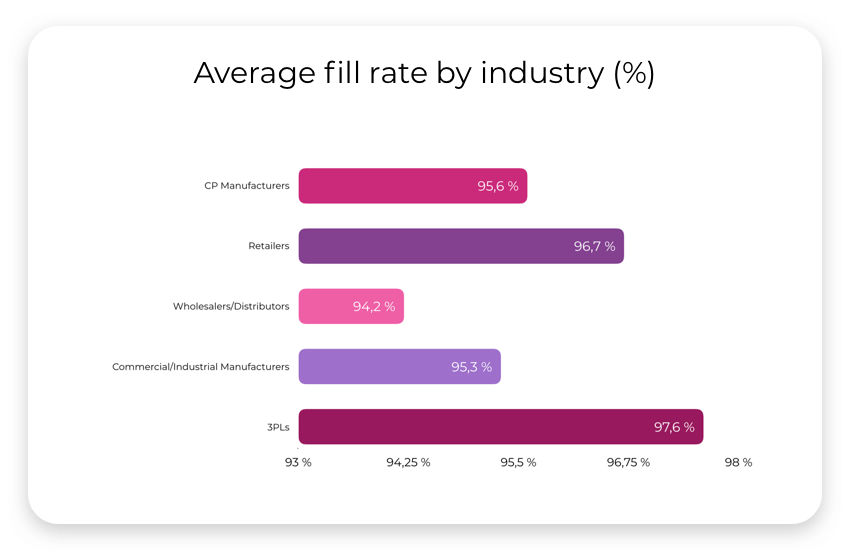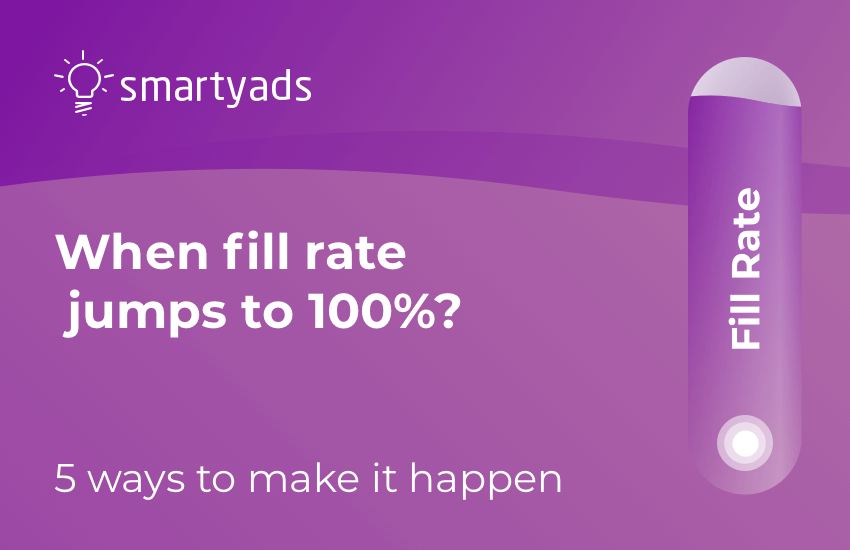No matter how good is your CPM, a poor ad network fill rate is a drag on your website monetization. If you send 5M ad requests but receive only 2.5M of impressions in return, you don’t use your inventory to the fullest.
This is like driving a trip on a half-empty bus when you sell 25 tickets having 50 seats in a vehicle. In other words, you receive only 50% of the possible revenue you could get with a full salon. If you are a publisher and your inventory isn’t sold out, the same thing is true for your incomes. In this case, the task is to find a strategy to improve your fill rate.
What Does a Fill Rate Mean in Advertising?
Here is the simplest fill rate definition:
Ad network fill rate is a number of displayed ads (a percentage of the total number of ad requests) that was able to satisfy the requests.
And there is an equally simple formula to calculate your fill rates:
Fill rate = # of Ads Served/ # of Ads Requested x 100%
If the number of ads requested on the network is 5M and 2.5M is the number of ads served, then your fill rate = 2.5M/5M x 100% = 50%.
With 50% fill rate you use only half of your available inventory. To support your revenue you need higher fill rates and also higher CPM (cost per one thousand impressions). So it doesn’t matter whether you get 5M ad requests of 1$ CPM and 50% fill rate or of 2$ CPM and 25% fill rate. However, these metrics are not interrelated, and nothing prevents you from increasing your fill rate regardless of your CPM value.
The Reasons Why Fill rates Drop
According to the Tompkins Supply Chain Consortium report, the leading publishers achieve a 98% fill rate, when the average is 94.7%. The fill rate will also depend on the industry, thus for the Wholesalers/Distributors it’s averaging at 94.2%, CP and Industrial Manufacturers reach up to 95.3% and 95.6%.

Let’s discuss the possible reasons why your fill rates may drop low. One of the main factors is the geolocation mismatch. If you target only traffic coming from your core countries, the visitors from the other countries are left off the board. For example, if your audiences mostly come from the EU and US, a visitor from India will not see any of your advertisements.
Visitors’ devices also matter. Most ad networks prefer to serve ads on smartphones since 52.2% of traffic is generated through mobile devices. Ads may be not displayed properly on smartphones based on minor mobile platforms like Blackberry or outdated versions of iOS and Android.
Another reason is the lack of advertisers — if the service you use is small and doesn’t have enough clients on the demand-side platform. Low website response times is also trouble — your website performs slowly and the user leaves before ads are uploaded to the page. Cookieless anonymous browsers are also obstacles: you can’t gather enough data for targeting.
Obviously, some of these factors are out of your control, still, you can utilize 5 following tips to maximize your fill rate.
Ad Fill Rate Improvement Tip #1: Serve Ads of a Universal Size
The most popular ad sizes are a large rectangle (336*280) and medium rectangle (300*250): they bring over half of all impressions. However, it’s better to set a flexible ad size in the ad placement, if you want to increase your fill rate and if it’s not critical for your website.
Removing the restriction on size, you heat up competition between advertisers. The number of ads bidding for the inventory slot increases so you get the better chance to close the deal quickly.
Ad Fill Rate Improvement Tip #2: Match Your Website to the Ad Network
Different ad networks provide different geo-targeting options. That’s why it’s important to find the right fit — if you target audience worldwide the ad network should have a global reach, not local. Otherwise, you won’t be able to target the demographics you need and inventory fill rate will decrease.
So, for instance, if you target the user pool from Brazil, look for ad networks that provide a continuous flow of campaigns targeted at Brazil or worldwide. In case you operate mostly on the Asian market, partner with a network that is focused on Asian demographics, etc.
Ad Fill Rate Improvement Tip #3: Try Different Ad Networks or Ad Exchange
Test multiple ad networks to reveal which ones yield the best results for your website. It’s also possible to collaborate with several networks at a time to ensure a 100% fill rate of each inventory slot.
A better option is to join an ad exchange. Ad exchanges operate similarly to ad networks, but they remove an intermediary in real-time bidding and give publishers more control over conditions determining for the ad placement.
An ad exchange features per impression buy & sell when an ad network works as a bulk trading system. This gives you an opportunity to fill unsold remnants and reach a fill rate close to 100%. For example, SmartyAds ad exchange is based on AI algorithms that ensure an unlimited demand for every impression you serve.
Ad Fill Rate Improvement Tip #4: Challenge Ad Blocking
According to the stats, 11% of internet users worldwide block ads on the web. This number grows by nearly 30% year-by-year making ad blockers a major threat for publishers’ revenue.
The catch is, your inventory fill rate may be displayed as 100%, but its real value will not exceed 89% if the above-mentioned 11% of visitors decide to block ads.
But there are a number of ways to bypass adblock. First of all, you can ask your visitors to whitelist your website. The second method is to use advanced interactive ad formats that easily bypass the blockers, such as playable or rewarded ads on mobiles.
Ad Fill Rate Improvement Tip #5: Embrace the Power of Header Bidding
Not all ad networks offer a 100% fill. However, those with a header bidding technology guarantee full sold out. Header bidding involves a header, an HTML element placed on a publisher’s website. When you have a visitor, the system sends a code to the header, so it automatically sends ad requests to DSPs and ad exchanges.
The average selling process resembles a waterfall: if nobody responds to the first requests, it runs further until somebody finally buys an impression. The header-bidding technology allows taking part in an auction for all advertisers simultaneously that means greater demand and possibility to close the deal with the highest bid offered.
SmartyAds header bidding solution not only improves your fill rate but increases your overall revenue offering your slots to multiple advertisers. Leveraging header bidding, you enhance the competition and select the best bid for each impression.




